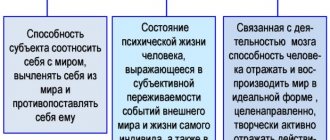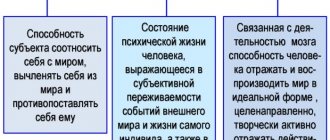Language concept
Language opens up other people's thoughts in unique ways, making them accessible to multiple and subtly nuanced influences. Included in the process of real practical relationships, the joint activity of people, speech through a message includes human consciousness. Through speech, one person's consciousness becomes self-evident to another.
The main function of consciousness is the perception of existence, its reflection. Language and speech perform this function in a certain way: They reflect existence by pointing to it. Speech, like language itself, is primarily a symbolic reflection of existence. But speech and language are both. They denote two different aspects of one whole.
Speaking is the activity of communicating—self-expression, influence, exchange—through language; speech is language in action. Language, whether together with speech or separately from it, represents the unity of a given activity - communication - and a given content, signifying and denoting, reflecting existence. More precisely, language for another is a form of existence of consciousness, which serves as a means of communication with it, and a form of generalized reflection of reality, or a form of existence of thought.
Speaking is the functioning of language in the context of individual consciousness. Accordingly, the psychology of speech differs from linguistics, which studies language; in this case, the specific object of the psychology of speech is determined, in contrast to the psychology of thinking, feeling, etc., which is expressed in the form of language. Generalized meanings recorded in language, reflecting social experience, are acquired in the context of individual consciousness, in combination with motives and goals that define speech as an act of individual activity, individual meaning or significance, reflecting the personal attitude of the speaker - not only his knowledge, but also his experience in the indissoluble unity and interpenetration in which they are given in the consciousness of the individual. Just as individual consciousness differs from social consciousness, psychology from ideology, so speech differs from language. At the same time, they are interconnected: Just as individual consciousness is mediated by social consciousness, human psychology by ideology, so language, and therefore the linguistic thought of an individual, is conditioned by language: Only through the forms of social thought, deposited in language, can a person formulate your own thought in your own language.
Language and words are a specific unity of sensory and semantic content. Every word has a semantic content, the semantic content of which is its meaning. A word means the object that it represents in a generalized form. The meaning of a word is a generalized reflection of its object.
But meaning is not a passive reflection of the object itself, as a thing in itself, outside of practical effective relations between people. The meaning of a word, which is a generalized reflection of an object involved in real, effective social interactions between people, is determined by the function of this object in the system of human activity. Since it is formed in social activities, it is involved in the process of communication between people. A word is a cognitive relationship of human consciousness to an object, mediated by social relations between people.
Language is a special, more advanced form of communication, unique to humans. There are two parties involved in this process - the speaker and the listener. The speaker selects the words necessary to express his thoughts, combines them according to the rules of grammar and speaks through the organs of speech. The listener perceives. Both should have the same rules and means of conveying thoughts.
Research methods
Speech in psychology is a form of manifestation of thought, as well as a process that affects and integrates any mental activity. The most common method of its research is association tests. They determine the connections between the meaning and meaning of words by assessing the timing and content of the reaction. The first serves as an indicator of the speed of primary nervous activity, and the second as a criterion for the intensity of association processes and the emotional state of the subject.
These experiments allow us to evaluate the characteristics of associations and the dynamics of the mental-speech function; they include the following methods:
- A paired study makes it possible to identify the one who prevails in terms of speed and dominance of associations from two subjects. To do this, both subjects are simultaneously given a stimulus, to which they respond out of turn with any words that come to mind.
- The free trial, which was first conducted by Swiss psychiatrist Carl Gustav Jung, is similar to the paired technique. During this process, the subject must respond to the stimulus as quickly as possible with any word that comes to mind. This allows you to assess the dynamics of his feelings, motivation and attitudes.
- Research on written communication skills. Literacy, clarity of presentation, understandability of handwriting and other criteria of the experiment reveal the nuances of mental and mental development.
- Chain research measures the number of emerging associations in a certain period of time without taking into account their latent formation. To do this, the subject says any words, without taking into account their surroundings. The evaluation criteria are the individual and average sizes of semantic nests, their number and the length of the associative series. The norm is 3-4 sockets per minute with 5-6 words in each.
- The method of unfinished sentences by Sidney Levy and Joseph Sachs determines a person’s attitude towards himself, the world around him, the characteristics of his behavior, as well as the nature of his work, partnership and family ties.
- Directed research involves responding to a stimulus with an association in accordance with given conditions. To do this, the process is given a specific semantic direction; the selected word is usually a synonym or a definition related to the content of the instruction. This experiment shows the level of speech development; the norm is the absence of exceptions in reactions that satisfy the conditions.
- The study of the semantic differential allows us to assess the emotional state of a person by his voice. Its author is US psychoacoustician L. Solomon. During the experiment, an individual listens to the same statements with a neutral meaning, pronounced with different emotions. The subject must indicate the presence of certain qualities in them on a scale from -3 to +3. These include general voice perception, arousal, anxiety and anger.
Speech is the object of a wide range of purposes, in addition to transmitting information, allowing for diagnosis, treatment, influence, training and other processes requiring interaction. The pioneer of the relationship between aphasia and brain regions and hemispheres, even before research in psychology, was Mark Dax, who was ahead of Paul Broca, but the work of this French scientist did not attract public attention.
Despite the opinion that speech is the difference between humans and animals, some of them can also be taught verbal methods of communication. Some species are even able to communicate meaningfully rather than imitate humans. The main means of such communication are gestures and signs, since the pronunciation of words is often hampered by the physiology of animals.
Author: Cash Diver
Types of languages
Depending on the variety of its functions, language is a polymorphic activity, that is, it manifests itself for various functional purposes in various forms and types. In psychology, there are two main forms of language:
External speech is a system of sound signals, written signs and symbols used by a person to transmit information, the process of materializing thoughts. External speech can be characterized by:
- Jargon;
- Intonation.
Jargon is a stylistic feature of the speech of a narrow social or professional group of people. Intonation is a set of speech elements that phonetically organize speech and are a means of expressing various meanings and their emotional coloring.
External speech is used for communication, so its main property is accessibility to the perception of other people. Depending on whether sounds or written symbols are used for this purpose, a distinction is made between oral and written language. Oral and written languages have their own psychological characteristics. When a person speaks, he perceives the listener, his reaction to his words. Written language is addressed to an absent reader who does not see or hear the writer, who will read what is written only after some time. Often the writer does not know his reader at all and does not maintain contact with him. The lack of direct contact between the writer and the reader leads to certain difficulties in constructing a letter. The writer is deprived of the opportunity to use expressive means to better express his thoughts, as happens in oral speech. Thus, written language is usually less expressive than spoken language. In addition, written speech must be especially voluminous, coherent, understandable and complete, that is, processed.
But written speech has one more advantage: unlike oral speech, it allows you to work long and carefully on the oral expression of thoughts, while in oral speech delays are unacceptable, there is no time for polishing and finalizing sentences. For example, if we look at the draft manuscripts of Leo Nikolaevich Tolstoy or Alexander Sergeevich Pushkin, we will notice their unusually painstaking and demanding work on the verbal expression of thoughts. Written language comes later in the history of society, as well as in human life, than oral language and is formed on its basis. The importance of written language is extremely high. It enshrines the entire historical experience of human society. Thanks to writing, the achievements of culture, science and art are passed on from generation to generation.
Thus, the external address includes the following types:
- Oral:
- dialogic;
- Monologue;
- written.
Types of external speech.
Oral speech is communication between people by pronouncing words out loud, on the one hand, and perception through hearing, on the other.
Depending on various communication conditions, oral speech takes the form of dialogic or monologue speech.
Dialogue is a type of speech consisting of alternating sign information from two or more subjects. Dialogue speech is a conversation in which at least two interlocutors participate. Dialogical speech, psychologically the simplest and most natural form of communication, occurs in direct communication between two or more interlocutors and consists mainly of exchanges of remarks. A remark is an answer, an objection, a commentary on the words of the interlocutor - it is characterized by laconicism, the presence of interrogative and annoying sentences, and syntactically non-expanding constructions. A characteristic feature of dialogue is the emotional contact of speakers, their mutual influence through facial expressions, gestures, intonation and timbre of voice. In everyday dialogue, partners do not care about the form and style of expression and are open. Participants in public dialogue take into account the presence of the audience and construct their speech literary. In everyday and ordinary conversation, dialogic speech is not planned. This is confirmed by speech. The direction of such a conversation and its results are largely determined by what its participants say, their remarks, comments, agreement or disagreement. But sometimes the conversation is organized purposefully to clarify a specific issue, then it is purposeful.
Dialogue speech usually places fewer demands on the construction of a holistic and developed speech than monologue or written speech; no special training is required here. This is explained by the fact that the interlocutors are in the same situation, perceive the same facts and phenomena, and therefore understand each other relatively easily, sometimes without a word. They do not need verbal expression. An important condition for the interlocutor in a dialogue presentation is the ability to fully listen to the partner’s statements, understand and respond to his objections, and not to his own thoughts.
A monologue is a type of speech that has a plot and represents a complex syntactic whole, which is structurally not at all related to the speech of the interlocutor. Monologue speech is the speech of one person presenting his or her thoughts over a relatively long period of time, or the sequential, sequential presentation of a system of knowledge by one person.
Monologue speech is characterized by:
- Consistency and evidence to ensure consistency of thinking;
- grammatically correct phrase;
- Expressiveness of vocal means.
Monologue speech is more complex in terms of content and language acquisition than dialogue, and always presupposes a fairly high level of development of the speaker’s language. There are three main types of monologue speech: narrative, descriptive and argumentative, which, in turn, are divided into subtypes with their own linguistic, compositional and intonation-expressive features. With speech disorders, monologue speech is disrupted to a greater extent than dialogic speech.
A monologue is an extended utterance of a person that is completed in semantic terms. The psychological and pedagogical feature of monologue speech is that the reactions of listeners are guessed, gestures and facial expressions play a smaller role than in dialogue. A monologue is, as a rule, a public speech addressed to a large number of people. An orthographic monologue is dialogic.
The speaker appears to be communicating with the audience, i.e. a latent dialogue occurs. But open dialogue is also possible, for example by answering questions from the audience.
Monologue speech involves one person speaking while others simply listen and do not participate in the conversation. Monologue speech occupies a large place in the practice of communication between people and is manifested in a variety of oral and written speech. Monologue forms of speech include lectures, reports, and speeches at meetings. A common and characteristic feature of all forms of monologue speech is a pronounced focus on the listener. The purpose of this orientation is to achieve the necessary influence on listeners, to give them knowledge, to convince them of something. Accordingly, monologue speech is extended in nature, requires a coherent presentation of ideas and therefore requires preliminary preparation and planning.
As a rule, monologue speech proceeds with a certain tension. This requires the speaker to be able to logically and consistently express his thoughts, express them clearly and distinctly, as well as the ability to establish contact with the audience. To do this, the speaker must monitor not only the content of his speech and its external structure, but also the reaction of the audience.
The loss of information in a monologue message can be up to 50%, in some cases even up to 80% of the original volume of information.
Written language is a graphically designed language organized around alphabetical patterns. It is aimed at a wide range of readers, is not situational and requires them to have advanced skills in analyzing sounds and letters, the ability to logically and grammatically correctly convey their thoughts, analyze what is written, and improve the form of expression.
Written and spoken language usually serve different functions. Spoken speech usually functions as spoken language in a conversational situation, while written speech functions as more impersonal business speech that is not directly directed at the person present. Written language usually aims to convey more abstract content, while spoken language usually arises from direct experience. Thus, there are a number of differences in the construction of written and oral speech, as well as in the means used in each specific case.
In oral, colloquial speech, the presence of a common situation that unites interlocutors creates a common set of immediately obvious assumptions. If the speaker reproduces them in speech, then the speech will seem overly long, tedious and pedantic: much stems directly from the situation and can be omitted in oral speech. There is a certain commonality between two interlocutors who share a common situation and, to some extent, a common experience. Sometimes between two people who are very close, just a little hint is enough for you to understand. Thus, what we say can be understood not only, and sometimes not so much, from the content of the speech itself, but from the position of the people who are talking to each other. So in colloquial speech people disagree on many things. Speaking language is situational speech. Moreover, in colloquial speech, which concerns the content of speech, we have a number of expressive means with the help of which we convey what is not fully formulated in the content of speech.
In written speech addressed to an absent or completely impersonal, unknown reader, one cannot expect that the content of the speech will be supplemented by general experiences from direct contact resulting from the situation in which the writer finds himself. Writing, therefore, requires a different structure than oral speech - an expanded linguistic structure, a different disclosure of the content of thought. In writing, it is necessary to uncover and reflect on all the relevant contexts of thinking. Writing requires a more systematic and consistent presentation. Everything written must be understood solely from its own semantic content, from its context; written language is contextual language.
Writing is oral communication in written texts. It can be delayed or direct. Written language differs from oral language not only in the use of writing, but also grammatically and stylistically - typical syntactic structures and specific functional styles. It has a very complex compositional and structural organization, which requires special mastery, and this gives rise to the special task of teaching writing at school. Since written text can be experienced simultaneously, or at least in large “chunks,” the experience of written language is very different from the experience of spoken language.
Audio Communication Features
Any child, gradually developing, begins to master first gestures and movements, and then moves on to the perception and use of sounds, which later become connected speech, taking into account all the rules and traditions accepted in a given ethnic group.
Communication through sounds has its own functions, which emerged gradually and do not reflect the functions of speech:
- Investment in the spoken word has an emotional connotation, which allows you to influence the perception of the opponent and, in some cases, increases the possibility of benefiting from the contact.
- Imitation of sounds - thanks to sound imitation, some objects, creatures and phenomena got their names, since this phenomenon is designed to reflect the sound they make.
- The expression of thoughts is associative. Some objects got their names due to their similarity to other objects. So, for example, a tree leaf is called so because of the sound it makes; a paper leaf took its name from it - the sounds of folding were similar to the rustling of trees. But the rolled sheet is externally associated with paper and has the same name. Thus, a number of associations gave three completely different objects the same name.
Inner speech
Inner speech is speech without sound design and occurs using linguistic meanings, but outside the communicative function; internal statement. Inner speech is speech that does not perform the function of communication, but only serves the thinking process of a particular person. It is distinguished in its structure by its coagulability and the absence of secondary members of the sentence. The internal language can be described as predictive.
Predictiveness is a feature of internal speech, which is expressed in the absence of words representing the subject, and the presence of only words related to the predicate.
Internal speech differs from external speech not only in that it is not accompanied by loud sounds, but also in that it is “speech minus sound.” Inner speech also differs from external speech in its function. In some respects it differs from external speech in its structure; for, as a rule, it is subject to some kind of change as it moves through different environments. Not intended for others, inner speech allows for “shortcuts”; it is often elliptical, omitting what seems obvious to its user. Sometimes it is predictive: it describes what is asserted, but leaves it out as self-evident, as knowledge of what is said; it is often constructed as an outline or even a table of contents, outlining as the object of thought what is said, and descending as knowledge of what is to be said.
Acting as internal speech, language abandons the main function that created it: it ceases to directly serve as a means of communication in order to become, first of all, a form of internal mental activity. However, internal speech, like any speech, far from serving the purpose of communication, it is of a social nature. Firstly, it is social in its genetic origin: “internal” speech is undoubtedly a form derived from “external” speech. It has a modified structure as it develops under different conditions; but even this altered structure bears distinct traces of its social origin. Inner speech and verbal discursive thought, which takes the form of inner speech, reflect the structure of language that has developed in the process of communication.
Inner speech is also social in content. The statement that inner speech is speech to oneself is not entirely true. Inner speech is usually addressed to the interlocutor. Sometimes this is a specific, individual interlocutor. I find myself,” I read in the letter, “continuing endless hours of internal conversation with you; and inner speech can be internal conversation.” It can happen, especially in a tense state of feeling, that a person talks inside with another person and tells him in this imaginary conversation everything that he could not tell him in a real conversation for one reason or another. But even in those cases when inner speech does not take on the character of an imaginary conversation with a specific interlocutor, then it is devoted to reflection, argumentation, reasoning, and then addresses a certain audience. Each person's thought, expressed in words, has its own audience, in the atmosphere of which his reasoning takes place; his internal reasoning is usually intended and tuned to this audience; inner speech, as a rule, is addressed internally to other men, if not to a real, then at least to a possible audience.
Inner speech is the internal, silent process of speech. It is invisible to others and therefore cannot be a means of communication. Inner speech is the verbal shell of thought. Inner speech is very peculiar. It is very short, condensed, almost never in the form of full, extended sentences. Often entire sentences are reduced to one word. This is explained by the fact that the subject of his own thought is completely understandable, which means he does not need to expand the verbal formulation. The help of expanded inner speech is usually resorted to in cases where difficulties arise in the thinking process. Sometimes the difficulties that arise when trying to explain to another person an idea that one understands are explained by the difficulty of moving from abbreviated internal speech, which is understandable to oneself, to developed external speech, which is understandable to others.








